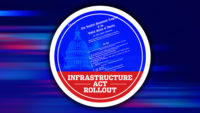Since July, the Federal Railroad Administration has pushed to obligate more than $2 billion for high-speed rail, most of it provided by the 2009 stimulus act and, since then, awarded to states and Amtrak. Obligations are a key milestone. Karen Rae, FRA deputy administrator, says, “It basically clears the way for project delivery, ranging from environmental [studies], preliminary engineering, final design and, in many cases, construction.” Industry firms welcome the new work because markets are tough and nearly all other American Recovery and Reinvestment Act infrastructure aid has dried up.
Peter Gertler, HNTB senior vice president, sees FRA's actions as good news. He says, “I think what it means is a lot of these states that were awarded these grants are now going to be able to start to select consultants and actually begin the work that is anticipated. So there's a whole sort of menu of works that will be getting done.”
Since 2009, FRA has received about $10 billion for high-speed rail (HSR)—$8 billion from ARRA and $2 billion in other appropriations. As of Sept. 30, it had obligated $7.8 billion of the ARRA funds and $313 million of the other funds. David Carol, Parsons Brinckerhoff's market leader for HSR, says, “I think FRA and the states that receive the money are as anxious to get this money working as soon as possible. And the economy certainly seems to need the stimulus just as much now as it did two years ago.”
Why the burst of obligations now? FRA has had to build a new program nearly from scratch, starting in 2009, then sort through a flood of grant applications. After awarding grants, there were lengthy negotiations with states and freight railroads, on whose lines many projects are located. Agreements for some big projects were wrapped up in recent weeks. FRA Administrator Joseph Szabo has said he wanted to get as much HSR funding obligated as possible by Sept. 30, one year before uncommitted ARRA rail money lapses.
Rae says the wave of obligations “wasn't in response to anything other than our desire to get these good projects obligated, get good agreements in place and get the jobs started as soon as possible.” But having funding obligated could protect the money from congressional rail critics who might want to rescind it.
The near-term outlook for new rail funds is grim. In April, Congress cut all fiscal 2011 HSR aid. For fiscal 2012, a House appropriations subcommittee recommended zeroing out HSR funds, and the Senate Appropriations Committee approved only $100 million.
Rae says the $10 billion FRA has now is an “unprecedented” sum for rail. She adds, “We intend to stay focused on showing what that $10 billion can do for the country.” As rail work gets under way, Carol says the hope is that there will be “real results” to show Congress as it takes up next year's budget, “to demonstrate that projects are moving forward, that they are supported by the public.”
| Recipient | Project Type | Amount($ millions) |
|---|---|---|
| Amtrak | Track, elec. power, catenary, signals | 449.9 |
| N.Y. | Interlocking | 294.8 |
| N.Y. | Track, station | 149.3 |
| Calif | New route | 86.4 |
| Va. | Enviro. review, pre-engineering | 44.3 |
| Pa. | Track, signals | 40.0 |
| Mass. | Station | 32.5 |
| Wash. | Track (design, environmental review, construction); grade separation | 31.1 |
| R.I. | Track, station | 29.2 |
| Md. | Bridge (pre-engnrg., enviro. review) | 22.0 |
| Source: Federal Rairoad Administration |




Post a comment to this article
Report Abusive Comment